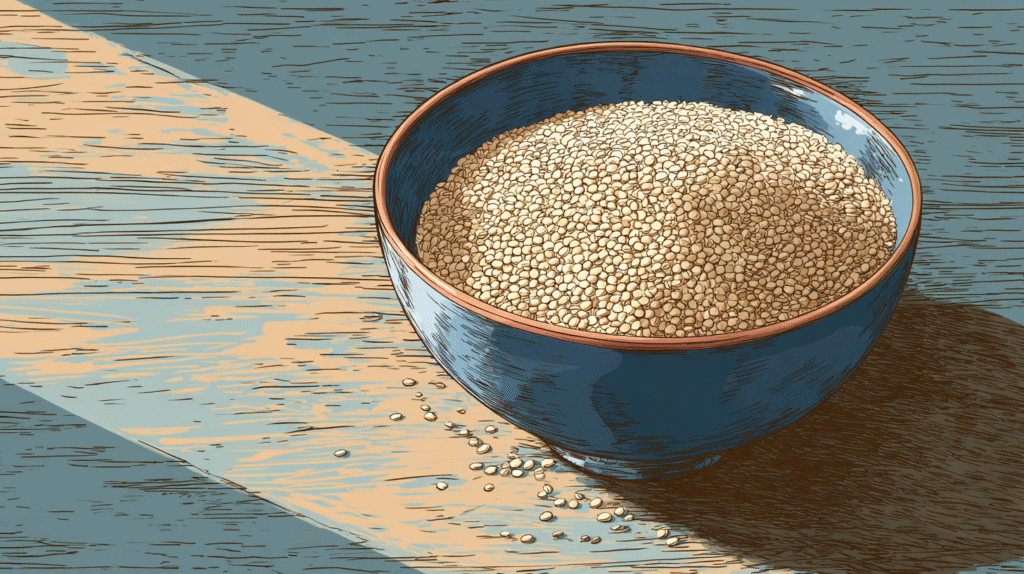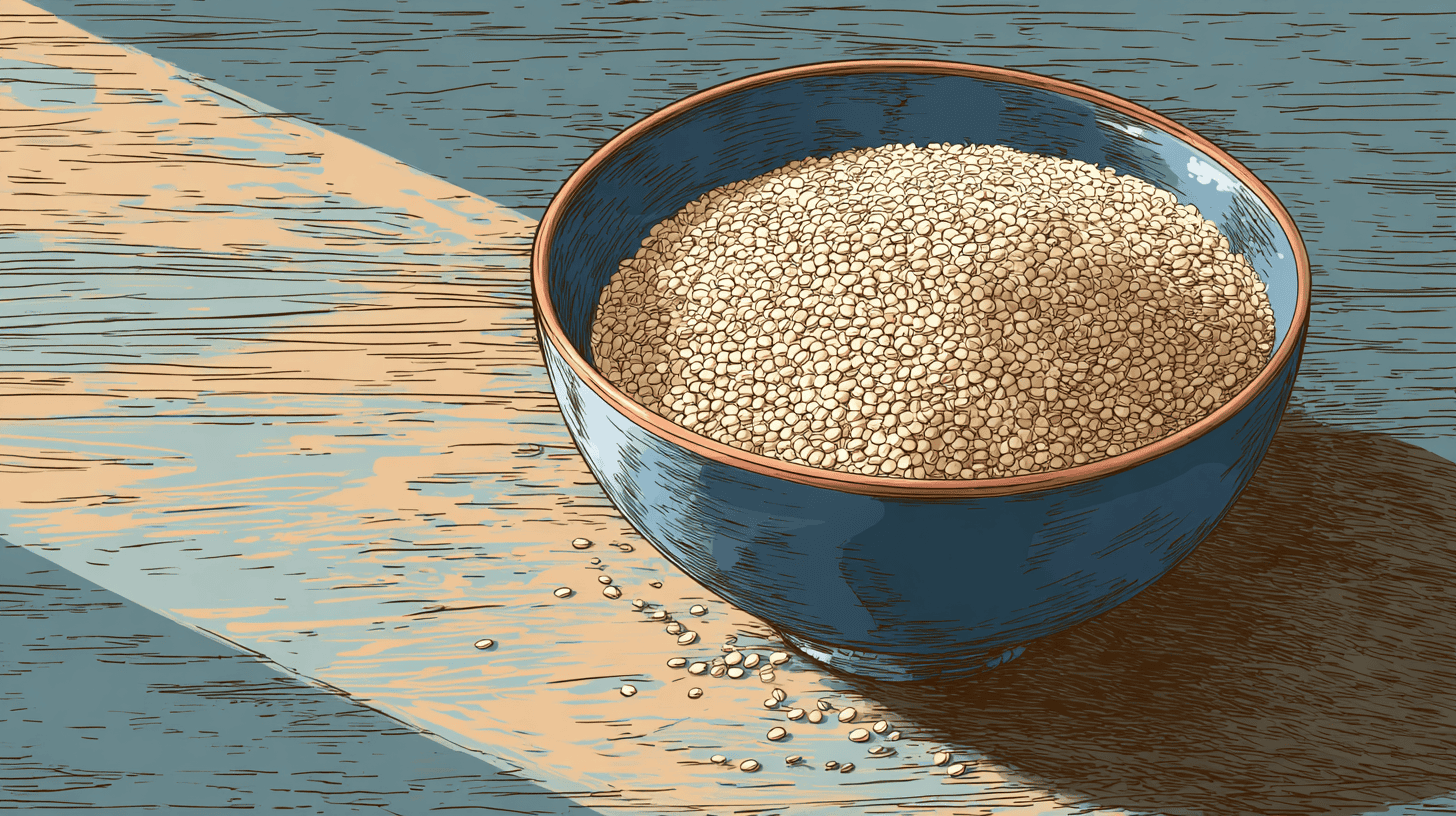Table of Contents
Quinoa and Diabetes: Evaluating Its Benefits and Impact on Blood Sugar Management
If you have diabetes or worry about your blood sugar, choosing the right foods matters. Quinoa pops up a lot as a healthy pick since it’s a whole grain loaded with protein, fiber, and nutrients.
Quinoa can be a smart choice for managing blood sugar and supporting your diabetes diet.
This seed stands out from most grains because it doesn’t cause those wild spikes in blood sugar. It’s got nutrients that help keep things steady and even support your heart—a big deal for anyone dealing with diabetes.
Trading out white rice for quinoa might give you a leg up on blood sugar control.
You can toss quinoa into salads, soups, or just use it as a side. It’s a pretty easy swap for higher-carb foods.
Getting a handle on how quinoa fits into your meals can help you make more confident choices.
Key Takeways
- Quinoa helps stabilize blood sugar due to its fiber and protein content.
- It offers important nutrients that support overall health in diabetes.
- Quinoa can replace higher-carb foods in your regular meals.
Understanding Diabetes and Diet
Managing type 2 diabetes? What you eat has a direct effect on your blood sugar levels. Carbs and the glycemic index are two things to keep an eye on.
Knowing how these work helps keep your blood sugar in check and lowers your risk for complications.
Role of Nutrition in Diabetes Management
Nutrition is a daily player in diabetes management. The body uses food for energy, but some foods make your blood sugar jump faster than others.
A balanced meal with protein, healthy fats, and fiber is key. Most diabetes meal plans focus on vegetables, whole grains, lean proteins, and healthy fats.
Keeping an eye on portions and when you eat matters too. It helps you avoid those frustrating blood sugar highs and lows.
How Carbohydrates Affect Blood Sugar
Carbs have the biggest impact on blood sugar. When you eat them, your body breaks them down into glucose, which then enters your bloodstream.
That’s what causes your blood sugar to rise. The type and amount of carbs you eat really matter.
Simple carbs (like sugar and white bread) spike your blood sugar fast. Complex carbs from whole grains and veggies digest slower, so your blood sugar stays steadier.

Importance of Glycemic Index for Diabetics
The glycemic index (GI) ranks foods by how much they raise blood sugar after eating. High GI foods mean a quick rise; low GI foods, a slower one.
Picking low to medium GI foods helps you dodge those sharp spikes. Quinoa, for example, sits at a low to medium GI and brings protein and fiber to the table.
Using the GI as a rough guide can make meal planning a bit less stressful.
Nutritional Profile of Quinoa
Quinoa is loaded with nutrients that support your health—especially if you’re managing diabetes. It’s got vitamins, minerals, fiber, and protein to help keep your body balanced.
Knowing what’s in quinoa can help you make smarter choices.
Macronutrients and Micronutrients in Quinoa
Quinoa’s a solid source of complex carbs and fiber. One cup of cooked quinoa has about 39 grams of carbs and 5 grams of fiber.
That fiber slows digestion and keeps those blood sugar spikes in check. Quinoa also brings iron, magnesium, and folate to the party.
Iron helps your blood carry oxygen, magnesium supports blood sugar regulation, and folate is good for cell health. There are even antioxidants in there, which help protect your body from damage.
Quinoa as a Complete Protein
Quinoa is one of those rare plant foods that gives you all nine essential amino acids. That makes it a complete protein—kind of like meat or eggs.
Each cooked cup has about 8 grams of protein. Protein helps with muscle repair and keeps you feeling full longer.
It also slows digestion, which is helpful for blood sugar control. Plus, quinoa is gluten-free, so it’s friendly for those with gluten sensitivities.
Quinoa and Blood Sugar Control
Quinoa influences your blood sugar in a few important ways. It helps keep glucose steady, supports insulin, and brings nutrients that make it easier for your body to handle sugar.
Effects of Quinoa on Blood Sugar Levels
Quinoa’s glycemic index is low to medium, so it raises blood sugar more slowly than foods like white rice or bread. That means fewer sudden spikes after you eat.
Some studies suggest quinoa can improve insulin sensitivity. Basically, your body uses insulin more effectively.
Including quinoa in your diet regularly could help with blood sugar control over time.
Fiber Content and Glycemic Response
Quinoa is high in fiber, especially the soluble kind. Fiber slows digestion, so sugar moves into your bloodstream more gradually.
Swapping refined grains for quinoa can help your body manage blood sugar better. Fiber’s also good for gut health, which might play a role in insulin regulation.
Antioxidants and Polyphenols in Quinoa
Quinoa’s got antioxidants and polyphenols, which help reduce damage from oxidative stress—a thing that’s linked to diabetes complications.
Polyphenols may lower inflammation and support insulin sensitivity. That means your body could use insulin more efficiently.
Comparing Quinoa to Other Whole Grains
Quinoa’s mix of protein, fiber, and carbs is different from other grains and legumes. Looking at how it compares can help you find what fits best for you.
Quinoa vs Brown Rice, Oats, and Barley
One cup of quinoa has about 8 grams of protein—more than brown rice, which has 5 grams. Quinoa also offers all nine essential amino acids, unlike most grains.
For fiber, quinoa and barley both have around 5-6 grams per cup. Oats have a bit less but do contain beta-glucan, which is good for cholesterol.
Quinoa’s GI is about 53, which is moderate and similar to barley and oats. Brown rice clocks in higher, around 68, so it can raise blood sugar faster.
| Grain | Protein (g/cup) | Fiber (g/cup) | Glycemic Index (GI) |
|---|---|---|---|
| Quinoa | 8 | 5 | 53 |
| Brown Rice | 5 | 3.5 | 68 |
| Oats | 6 | 4 | 55 |
| Barley | 3.5 | 6 | 28-55 |
Nutritional Differences With Beans, Lentils, and Peas
Beans, lentils, and peas aren’t grains, but they’re common plant-based protein sources. They usually have more fiber than quinoa—anywhere from 7 to 16 grams per cup.
They also have about 15-18 grams of protein per cup, nearly double what quinoa offers. But they don’t have all the essential amino acids on their own.
Combining them with grains like quinoa can boost protein quality. Their carbs have a low glycemic load, usually even lower than quinoa’s, so they cause a smaller blood sugar jump.
They’re also rich in minerals like iron and folate.
| Legume | Protein (g/cup) | Fiber (g/cup) | Glycemic Load (GL) |
|---|---|---|---|
| Black Beans | 15 | 15 | Low |
| Lentils | 18 | 16 | Low |
| Green Peas | 9 | 8 | Moderate |
Mixing quinoa and legumes in your meals can give you a nice balance of protein, fiber, and vitamins.
Incorporating Quinoa Into a Diabetes-Friendly Diet
Quinoa’s an easy way to add nutrition without sending your blood sugar through the roof. Knowing how much to eat, how to prep it, and how to work it into recipes can keep your meal plan interesting and balanced.
Recommended Portion Sizes and Meal Planning
For most people with diabetes, a serving size is about half a cup of cooked quinoa (roughly 90 grams). That helps control carbs while still giving you fiber and protein.
Try swapping quinoa for rice or bread in your meals. It’s great in salads, bowls, or as a side.
Balance things out by adding veggies, lean protein, and healthy fats alongside your quinoa. Tracking carbs is important—a typical meal plan aims for 45-60 grams of carbs per meal, so adjust your quinoa and pair it with low-carb foods.
Tips for Preparing Quinoa Meals
Rinse quinoa before cooking to get rid of its natural coating—it can taste a bit bitter otherwise. A good rule is 1 cup quinoa to 2 cups water or broth.
Bring it to a boil, then cover and simmer for about 15 minutes until the liquid’s gone. You can make a batch and keep it in the fridge for up to five days, which makes quick meals a breeze.
Try mixing quinoa with fresh veggies, beans, or herbs. A splash of lemon juice or a drizzle of olive oil can really brighten it up without adding sugar or salt.
Cultural Foods and Diverse Uses of Quinoa
Quinoa’s pretty versatile and fits into all sorts of global dishes. You can make a salad with tomatoes, cucumbers, and herbs for something light.
In South America, it’s common in soups and stews. You can use it in patties, swap it for rice in stir-fries, or even make breakfast bowls with nuts and fruit.
Don’t be afraid to experiment—keeping meals interesting can help you stick with your diabetes plan.
Potential Health Considerations
When adding quinoa to your diet, keep an eye on things like cholesterol and sodium. Some people might have allergies or mild side effects, especially if it’s new to them.
Managing Cholesterol and Sodium Intake
Quinoa is naturally low in cholesterol, which is great for your heart—something to think about if you have diabetes.
Just watch what you add to it. High-sodium sauces or salty toppings can sneak in extra sodium, which isn’t helpful for blood pressure or heart health.
Tips to manage sodium:
- Go for fresh herbs and spices instead of salt.
- Skip processed sauces.
- Rinse quinoa before cooking to cut any leftover bitterness or starch.
Potential Allergens and Side Effects
Most folks do fine with quinoa, but a few might get allergic reactions—think itching, stomach pain, or rash.
If you’re allergic to seeds or grains, talk to your doctor before trying quinoa. It also contains saponins, which can upset your stomach if you don’t rinse it well.
Start with small amounts and see how you feel. If you notice anything weird, stop eating quinoa and check in with your doctor.
Quinoa can actually be a pretty solid choice for managing diabetes. It’s packed with fiber and protein, both of which can help keep your blood sugar in check.
There are also plenty of vitamins and minerals in quinoa that your body will appreciate. Since it’s a whole grain, it tends to have a gentler effect on blood sugar than some other grains out there.
If you’re living with diabetes, quinoa might also help lower some risks tied to heart disease and high blood pressure. There’s even some talk about it helping your gut stay healthier, which—let’s be honest—doesn’t get enough attention when it comes to blood sugar.
Keep in mind:
- Quinoa isn’t a magic fix, but it can support you.
- Watch your portion sizes, especially if blood sugar is a concern.
- Pair quinoa with other good-for-you foods to keep things balanced.
Trying out quinoa in your meals could be a smart move. Just keep your diet varied, and maybe check in with your healthcare provider for advice that fits you.
